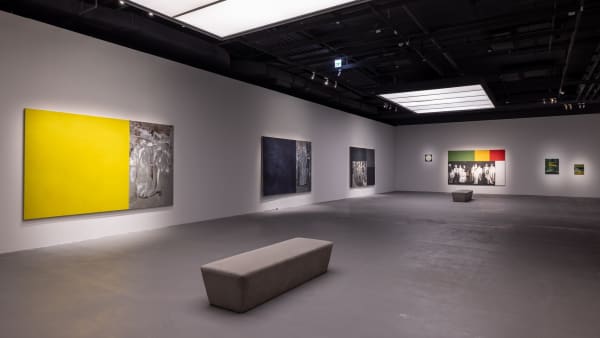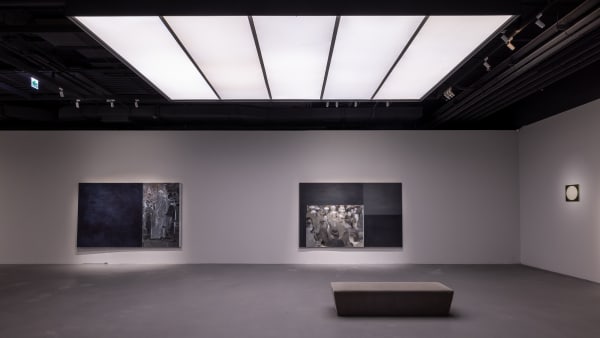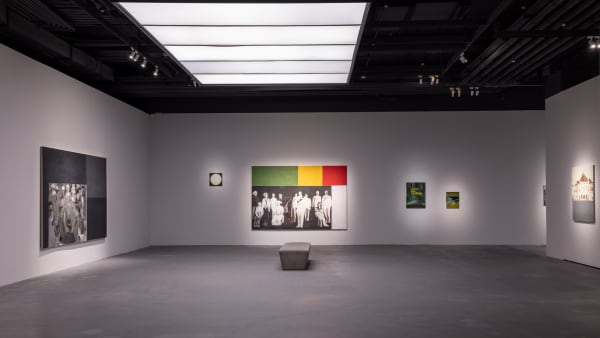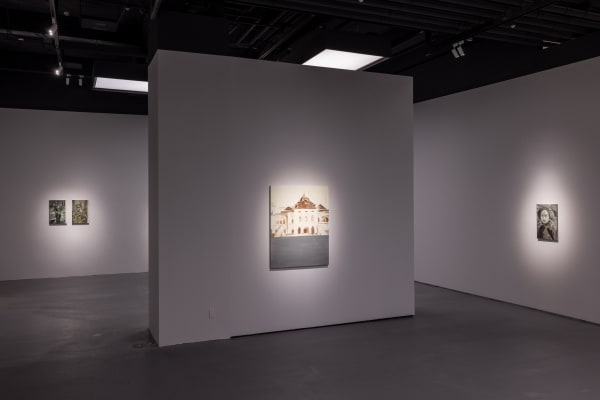Burmese History X : SAWANGWONGSE YAWNGHWE SOLO EXHIBITION
Dates
26 SEPTEMBER - 21 NOVEMBER 2020
Reception
26 SEPTEMBER, 4:30 p.m.
TKG+ B1, No.15, Ln. 548, Ruiguang Rd., Neihu Dist., Taipei 114, Taiwan
Counter-historiography and the discourse against Burmese-centric narratives from a localized, non-Burman perspective have always been the core of Sawangwongse Yawnghwe’s artistic practice. Yawnghwe’s work interweaves reality and fabrications from historic scenes, family photos, and his father’s notes left behind. With his meticulous research, he interacts with scholars of Burma, human-right activists, journalists, and writers. He employs research methodology to draw on philosophical discourses, reflecting upon the validity of history when ethnic minorities’ narratives are dissolved and eradicated. Meanwhile, he criticizes the merging of modernism with capitalism. His work depicts the paradoxical contradictions as well as political fluidity and its aftermaths.
Many Shans and other people from Burma have been in exile for decades. Compared with the literal definition of “exile,” the Shan story is further cast in a diasporic light, not only because of their forced expulsion by the military, but also because of poignant nostalgia for a homeland that no longer exists. Haunted by the shattered dream of returning home, Yawnghwe has long experienced loss for the homeland he never had. As Slavoj Žižek wrote in Absolute Recoil: Towards A New Foundation of Dialectical Materialism, Malcolm X adopted “X” as his family name, signaling the deprivation of familial ancestry, ethnic roots, and culture when his ancestors were sold and taken away from their homeland as slaves. Rather than summoning Africans to fight to return to their homeland, the idea was to encourage people to seize the opportunity provided by X — to acknowledge their new lack of identity caused by their enslavement that has forever stripped them of their roots.
To dismantle the idea of X, Yawnghwe takes X as the subject, and returns to the outset of the catastrophic exile of his family to start anew from ground zero, for his latest solo exhibition at TKG+, Burmese History X. It is another ontological new start in contrast to his former solo exhibition in 2019, Yawnghwe Office in Exile / State Museum / Absoluter Gegenstoss / Absolute Recoil, and will continue to develop. Yawnghwe’s painting can be defined as post-structuralism, which claims the impossibility for a neutral, omniscient point of view to exist outside a text. Based on the collection of family photographs and the archives he has compiled, he allows Burmese iconography and contemporary art to coalesce. By juxtaposing imagery of pictures with color blocks, the artist reimagines the figurative and the abstract as one single image. The sectioning and shifting of the re-presented images and color blocks render a space of liberation that is almost indescribable. The disruption of color blocks in the composition symbolizes the disintegration of traditional forms.
For Yawnghwe, the color blocks in the composition can be purely abstract, while sometimes the colors are selected deliberately, even the same color can stand for different meanings. For instance, the white, green, yellow, and red commonly seen in his work are also the Shan flag’s color. However, the green color sometimes symbolizes the Burma’s army, the yellow for Burma’s colonial rule, and the red for the courageous spirit and blood of the Shan people. Whereas the black could denote mystery, it could also be a salute to the monochromatic painting artist, Ad Reinhardt. The purple and the blue, on the other hand, bear a connection to royalty. These colors in the composition allow viewers’ imagination to expand poetically and bring abstraction closer to reality.
The phrases in Yawnghwe’s works are quotes from his father’s notes, written on pieces of paper clipped together and carefully kept with him for years. Yawnghwe considers the phrases as signifiers, bridging the concepts in his work just like family pictures. In his latest work on view in this exhibition, he combines these phrases with a new form of composition. For instance, in X18 (Faded into oblivion), X 29 (Saw Ba U Gyi) and X 37 (Sao Kya Seng), the images and phrases blend in with the hazy background, becoming a poetic manifestation of radical immaterialism and pure philosophy
Sawangwongse Yawnghwe
Sawangwongse Yawnghwe was born in Shan State of Burma in 1971. He comes from the Yawnghwe royal family of Shan. His grandfather, Sao Shwe Thaik, was the first president of the Union of Burma (1948–1962) after the country gained independence from Britain in 1948. Shwe Thaik died in prison following the 1962 military coup by General Ne Win. Since then, Yawnghwe’s family was driven into exile. They stayed in Thailand, then escaped to Canada, where Yawnghwe grew up and received education. He now lives and works in the Netherlands.
Yawnghwe’s painting and installation practice engages politics with reference to his family history as well as current and historical events in his country. Family photographs also provide the basis for a pictorial language through which he explores events in the country, suggesting that existing and available archives cannot reveal a nation’s entire truth. In addition, Yawnghwe’s work of maps charts the conflicts between drugs such as heroin and amphetamines, revolutionary armies, minority ethnicities, mining and gas pipelines, the armament of generals, and state genocide against its minorities. He intends to bring discernible order to a complex political situation.
Yawnghwe has exhibited internationally, including: Dhaka Art Summit (Bangladesh, 2020), the 9th Asia Pacific Triennial of Contemporary Art (Australia, 2018), the 12th Gwangju Biennale Exhibition (Korea, 2018), Qalandiya International — Jerusalem Show VIII (Jerusalem, 2016), Steirischer Herbst (Austria, 2016), Dak'Art 2016/the 12th Biennale of Contemporary African Art (Senegal, 2016), Indian Art Fair (India, 2016). He has also exhibited in numerous museums, including: National Museum of Modern and Contemporary Art – Seoul (Korea, 2020), Museum of Modern Art in Warsaw (Poland, 2018), Van Abbemuseum (Netherlands, 2018), MAIIAM Contemporary Art Museum (Thailand, 2018), IMMA Irish Museum of Modern Art (Ireland, 2016), and Stedelijk Museum Bureau Amsterdam (Netherlands, 2015). His work is housed in the collections of MAIIAM Contemporary Art Museum in Thailand and Singapore Art Museum.
VIEWING ROOM
















